Notes
The Visual Politics of the LA Fires
From a man rescuing Old Glory to a haunting ‘stairway to nowhere,’ key photos from LA’s devastating fires expose America’s most profound social divisions inflamed by Trump’s sabotage.
By Michael Shaw
In our latest short Chatting the Pictures video, Cara and I analyze a defining image from the LA fires: a man rescuing an American flag from a burning Altadena home, captured by Bloomberg photographer Jill Connelly.
This scene captures something I’ve been tracking for some time—how natural disasters become theater for the display of Old Glory. As climate catastrophes pile up, these demonstrations grow more frequent, and Trump’s threats to withhold disaster aid only heighten our national identity crisis.
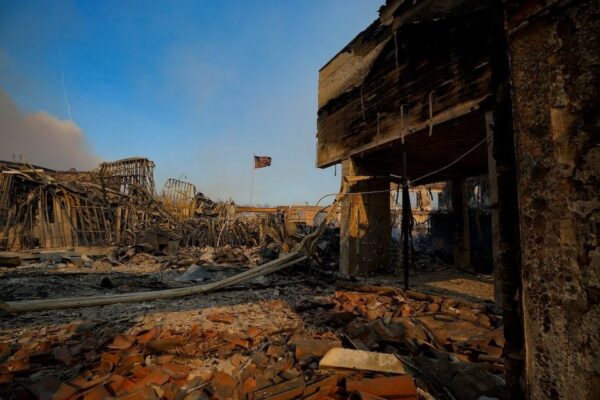
A U.S. flag flutters amid the remains of burnt buildings in the Pacific Palisades neighborhood of west Los Angeles, January 8. Mike Blake/Reuters
Below, I explore how the visual coverage of these devastating fires highlights social divides and climate denial while cutting through Trump’s endless stream of misinformation about California’s fire response.
Unprecedented
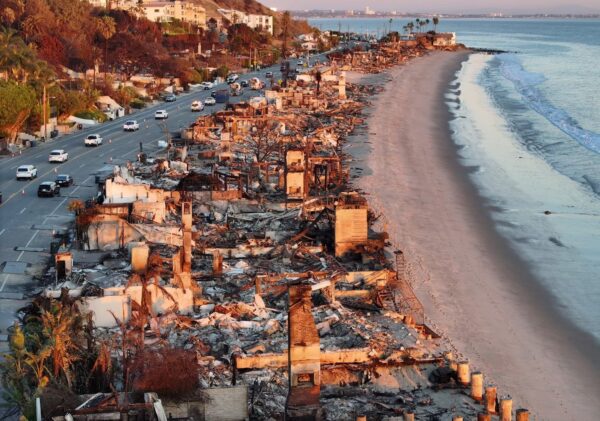
An aerial view of repair vehicles at sunset passing near beachfront homes burned in the Palisades Fire as wildfires cause damage and loss through the LA region on Jan. 15, 2025, in Malibu, Calif. Mario Tama/Getty Images
Despite Trump’s baseless claims about forest and water mismanagement, this aerial photo by Mario Tama exposes the stark reality of modern climate-driven fires. Despite its proximity to the Pacific Ocean and minimal vegetation in this stretch of Malibu, the fierce Palisades firestorm – driven by unprecedented 100-mph winds—jumped the Pacific Coast Highway and leveled everything in its path.

Via CBS. Photo uncredited.
I’m a believer in smart policy, but all the finger-pointing in the LA firestorm about hydrant flows and LAFD budgets seems like arguing about the adequacy of Hiroshima’s 1945 building code standards. It’s a way to evade the big questions.
— @markpaul.bsky.social
This dramatic photo of flames engulfing a seemingly fire-breathing fire hydrant is a perfect visual counterpoint to Trump’s misleading claims. While he spun tales about withheld water and policy failure, this image captures the brutal reality: When storage tanks designed for routine operations are drained by demands four times higher than usual for 15 straight hours, we’re not facing a management problem—we’re facing an existential one.
Fossil Fuel Ironies
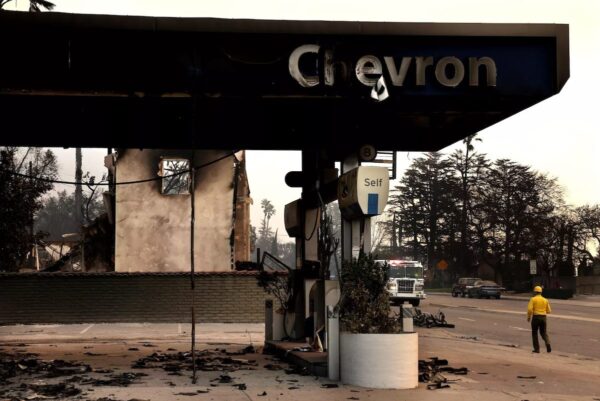
The Eaton fire in Altadena destroyed a Chevron gas station on Lake Avenue. Christina House/Los Angeles Times
There’s something darkly poetic about a Chevron gas station reduced to cinders – as climate change consumes the infrastructure that birthed it. And just to round out the cosmic irony, Chevron chipped in $1 million to relief efforts.

Donations left at a gas station in Altadena, California. Caroline Brehman/EPA, via Shutterstock
In a scene that perfectly captures our climate contradictions, a gas station’s forecourt becomes an impromptu aid center, its familiar corporate signage now presiding over piles of donated blankets, diapers, and essential supplies. The City of Los Angeles designated several stations as official donation centers.
Shocked, But Not Surprised
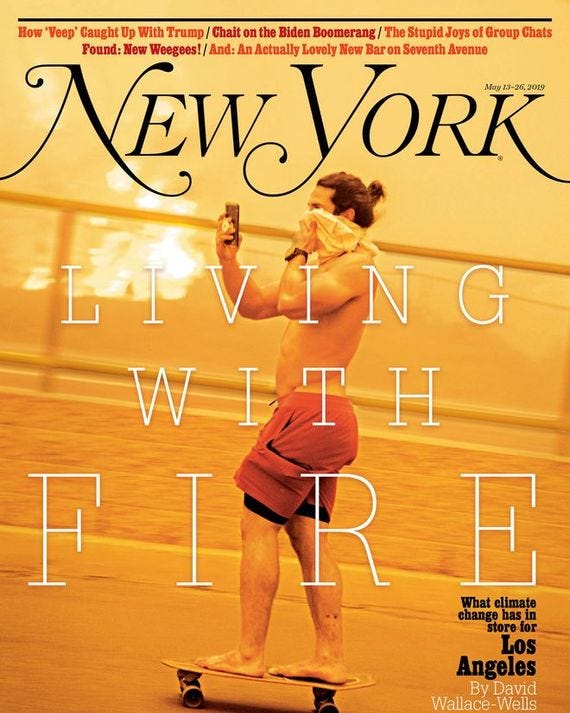
Cover photo: Stuart Palley. Day two of the Woolsey fire in Malibu in 2018.
The Woolsey fire photo on this 2019 New York Magazine cover now reads as a chilling prophecy fulfilled. Its apocalyptic Malibu scene perfectly presages today’s devastation across Los Angeles. The image captures a stark reality: Despite Southern California’s carefully cultivated ethos of endless summer and laid-back beach culture, the transformation of paradise into an infernal wasteland has become the new normal. David Wallace-Wells’ 2019 warning wasn’t just prescient—it documented the beginning of an inevitable cycle, where the unthinkable becomes routine in California’s climate-altered landscape.
Race, Class, and Culture
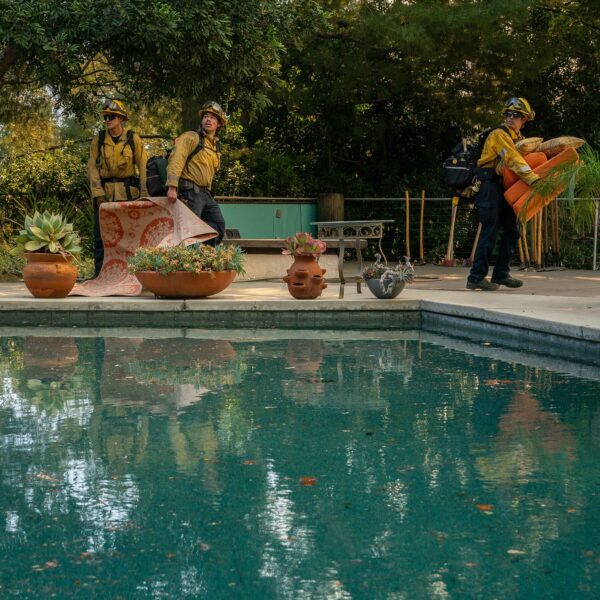
The Palisades fire burned at least one home in Mandeville Canyon, where two strike teams with seven helicopters and at least 10 fire engines were working to contain the blaze. Loren Elliott for The New York Times
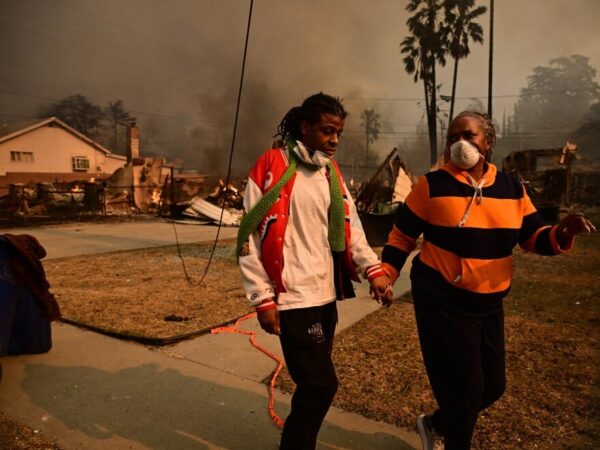
Wednesday, Jan. 8, 2025. Residents walk past homes burnt by the Eaton Fire. Robyn Beck / AFP Via Getty Images
The media coverage of the LA fires exposed a telling dichotomy in visual storytelling and social priorities. The Palisades coverage fixated on the spectacle of luxury – swimming pools, celebrity estates, and movie landmarks reduced to ash, creating a narrative that inadvertently privileged wealth and status. Meanwhile, in Altadena, a historically significant Black community built in resistance to discriminatory housing practices faced devastating losses with far less media attention.
This disparity in coverage raises profound concerns about equitable disaster response and recovery. The threat of gentrification looms particularly large, as many longtime residents may lack the financial means to rebuild, potentially erasing a vital piece of Los Angeles’s diverse cultural landscape that has persisted for generations.

Firefighters and disaster relief workers from Mexico’s National Forestry Commission and Ministry of Defense arrived in Los Angeles on Saturday to join the effort to extinguish the Palisades and Eaton fires. (Photo courtesy California Governor’s Office)
In a striking reversal of border politics, this tarmac scene shows Mexican firefighters and disaster workers being welcomed, not expelled. As crews from Mexico’s National Forestry Commission and Ministry of Defense arrive to battle LA’s fires, their unfurling of U.S., California, and Mexican flags suggests how natural disasters can bridge the gulf that politicians work so hard to maintain.
Visual Metaphors
The Iconic Stairway
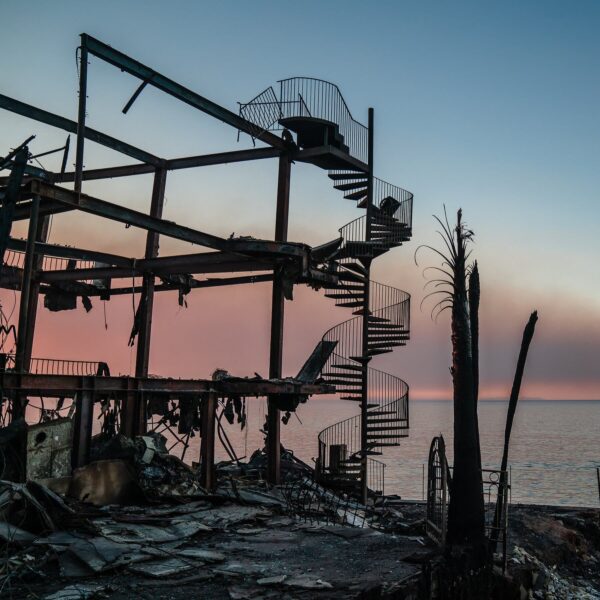
Ariana Drehsler for The New York Times
Malibu’s haunting “stairway to nowhere” was perhaps the most photographed symbol of the LA fires. While staircases traditionally embody ascension and progress, this truncated structure points skyward into emptiness – a brutal counterpoint to California’s cherished mythology of reinvention and upward mobility. The image resonates even more deeply as the fires consumed many treasured landmarks of California’s modernist architecture.
Car Culture
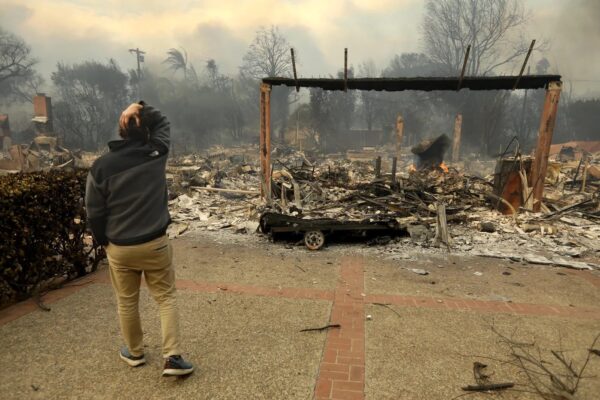
Pacific Palisades at 11:40 a.m. PT, January. 8, 2025, via New York Magazine. Genaro Molina/Los Angeles Times
In this surreal scene, a charred car appears almost toy-like against the devastation – its reduced scale making the destruction seem even more overwhelming. What was once a symbol of LA’s car culture is now just a skeleton, showing how climate can undermine a whole way of life.
School Protection
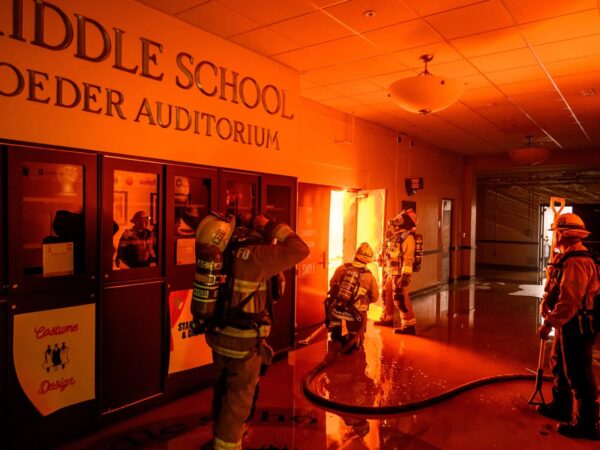
Wednesday, Jan. 8, 2025: Firefighters prepare to fight flames from inside Eliot Arts Magnet Middle School auditorium as the school burns during the Eaton fire in the Altadena area. Josh Edelson / AFP Via Getty Images
The sight of firefighters at Eliot Arts Magnet Middle School’s entrance creates an unsettling parallel to another American crisis. Their defensive stance at the auditorium doors eerily mirrors scenes of law enforcement responding to school violence. Yet unlike the hollow NRA rhetoric about hardening schools against shooters, the need to fortify our educational institutions against climate threats represents a tangible, science-based imperative. These first responders, framed in the doorway, stand as witnesses to how environmental catastrophe now directly threatens spaces meant to nurture our children’s future.
Disorientation
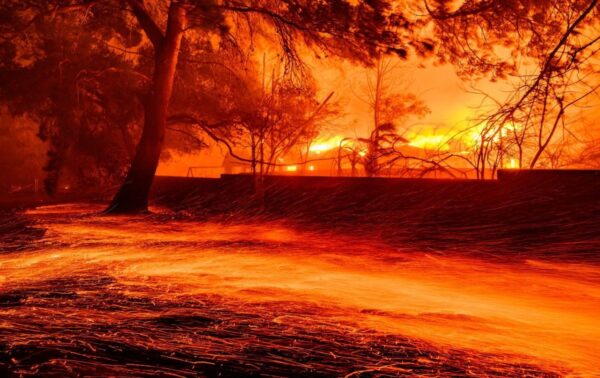
Embers whip across the ground as homes burn during the Eaton fire in Pasadena, California, on January 7, 2025. Josh Edelson/AFP
In a surreal landscape transformation, wind-driven embers trace luminous paths across the ground like a river of fire—nature mimicking water with its most destructive force. This haunting inversion, where fire flows like liquid across the California terrain, is a perfect metaphor for how climate change has warped our familiar world into something terrifying.
Final Reflection

iPhone photo. Palisades fire. Stuart Palley via Threads. Seven hundred firefighters continue to battle the Eaton Fire in Altadena, California. Justin Sullivan/Getty Images
Columns rise like ancient ruins while a cherubic sentinel stares from the gates of hell. The Palisades fire photo by Stuart Palley and Justin Sullivan’s haunting angel from the Eaton Fire are not just apocalyptic. As climate deniers double down, these pillars stand as silent witnesses to an empire charred by the heat of its own neglect.

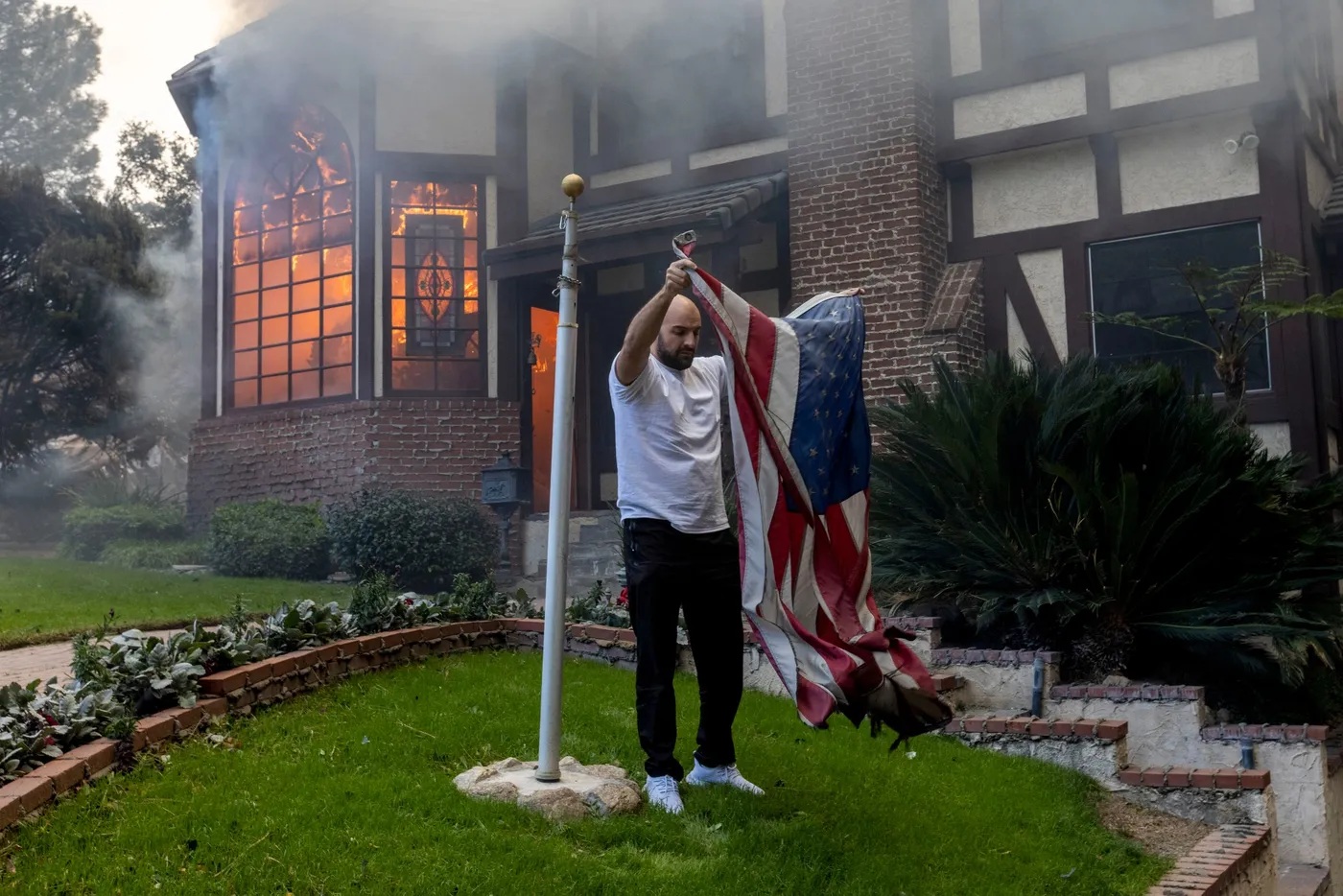
Reactions
Comments Powered by Disqus